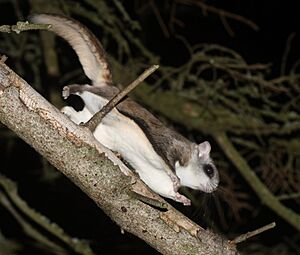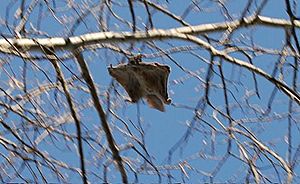Flying squirrel facts for kids
Quick facts for kids Flying squirrelTemporal range: Early Oligocene – Recent
|
|
|---|---|
 |
|
| Northern flying squirrel (Glaucomys sabrinus) |
|
| Scientific classification |
|
| Kingdom: | Animalia |
| Phylum: | Chordata |
| Class: | Mammalia |
| Order: | Rodentia |
| Family: | Sciuridae |
| Subfamily: | Sciurinae |
| Tribe: | Pteromyini Brandt, 1855 |
| Genera | |
|
Aeretes |
|
Flying squirrels are amazing creatures that belong to the squirrel family. There are about 50 different kinds, or species, of flying squirrels. Even though they are called "flying" squirrels, they don't actually fly like birds or bats. Instead, they are expert gliders!
They glide from tree to tree using a special furry skin flap called a patagium. This skin stretches like a parachute from their wrist to their ankle. Their long, bushy tails help them stay steady and steer while they glide through the air. Flying squirrels look a lot like other squirrels, but they have special body features that help them glide. For example, their arm and leg bones are longer.
Scientists have studied flying squirrels and found that they first appeared about 18 to 20 million years ago. Most flying squirrels are active at night, which means they are nocturnal. They eat a variety of foods, including fruit, seeds, flowers, insects, spiders, and even fungi.
Baby flying squirrels are born without fur and cannot see or hear at first. Their mother takes care of them in a cozy nest. By the time they are five weeks old, they start practicing their gliding skills. When they are about ten weeks old, they are ready to leave the nest and live on their own. Some southern flying squirrels that were raised by humans have even become "pocket pets" in homes!
Contents
How Flying Squirrels Glide
Flying squirrels are not true flyers like birds. Instead, they are incredible gliders. They can glide for long distances, sometimes up to 90 meters (about 300 feet)!
When a flying squirrel wants to glide, it launches itself from a high point on a tree. It spreads its limbs wide, stretching out its patagium. This creates a large surface area that catches the air, allowing it to glide smoothly.
They can change their direction and speed in mid-air by moving their arms, legs, and tail. Flying squirrels have a special piece of cartilage that sticks out from their wrist. They hold this upward during a glide. This unique feature helps them control their flight path. Their fluffy tail also works like an air brake to help them slow down before landing gently on another tree trunk.
Scientists think gliding helps flying squirrels save energy. It's much easier to glide from tree to tree than to climb down one tree and then up another. Gliding also helps them find food faster. They can cover a larger area of the forest quickly, looking for tasty treats. They can glide at speeds from about 8 to 32 kilometers per hour (5 to 20 miles per hour).
Gliding also helps them escape from danger. If a predator appears on one tree, the squirrel can quickly glide to another tree, getting away from the threat.
Pink Glow: A Mystery
In 2019, something very interesting was discovered about flying squirrels. Scientists found by chance that flying squirrels glowed pink under UV light! This glowing effect is called fluorescence.
Researchers at Northland College in Wisconsin then studied all three types of North American flying squirrels. They found that all of them glow pink under UV light. It's still a mystery why they do this. Other squirrels that don't glide do not glow under UV light.
Where Flying Squirrels Live
There are three types of flying squirrels found in North and Central America. These are the Northern flying squirrel, the Southern flying squirrel, and Humboldt's flying squirrel. Many other kinds of flying squirrels live across Asia. The Siberian flying squirrel can even be found in parts of northeastern Europe, like Russia, Finland, and Estonia.
Life in the Wild
Flying squirrels usually live for about six years in the wild. However, they can live much longer, up to fifteen years, when they are cared for in zoos. Many young flying squirrels don't survive because of predators and diseases.
Many animals hunt flying squirrels. These predators include tree snakes, raccoons, owls, martens, fishers, coyotes, bobcats, and even feral cats. In some parts of North America, the northern spotted owl is a common predator of flying squirrels.
Since flying squirrels are active at night, they are better at avoiding birds of prey that hunt during the day.
What Flying Squirrels Eat
Flying squirrels are omnivores, which means they eat both plants and animals. They eat whatever food they can find in their environment.
The North American southern flying squirrel enjoys a varied diet. It eats seeds, insects, slugs and snails, spiders, shrubs, flowers, fungi, and even tree sap. They also like fruits, nuts, and birds' eggs. Their excellent sense of smell helps them find food easily in the dark.
Baby Squirrels and Their Growth
The mating season for flying squirrels is usually in February and March. After the babies are born, the mother squirrel stays with them in a special nest. She takes care of them and protects them until they are old enough to leave. Male squirrels do not help raise the young.
When they are born, baby flying squirrels have very little hair, except for their whiskers. They can't see or hear yet. You can even see their internal organs through their skin! By five weeks old, they are much more developed and start to react to their surroundings.
In the weeks that follow, they practice leaping and gliding. By about two and a half months old, their gliding skills are perfect. They are then ready to leave the nest and live independently.
See also
 In Spanish: Pterominos para niños
In Spanish: Pterominos para niños


